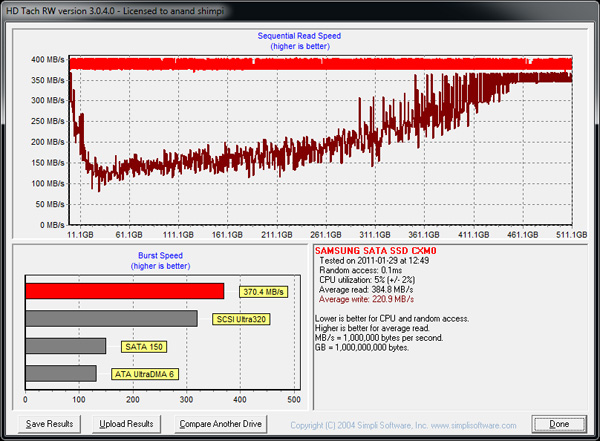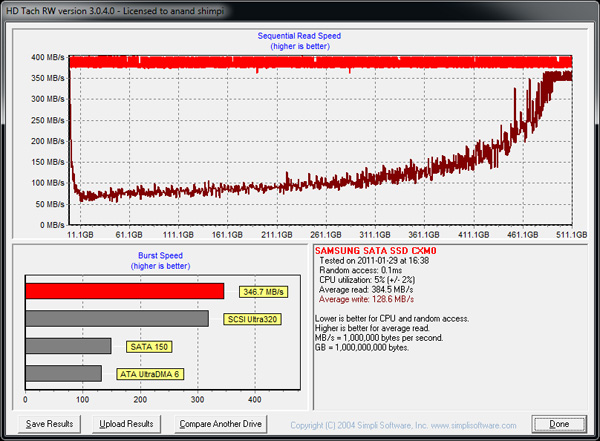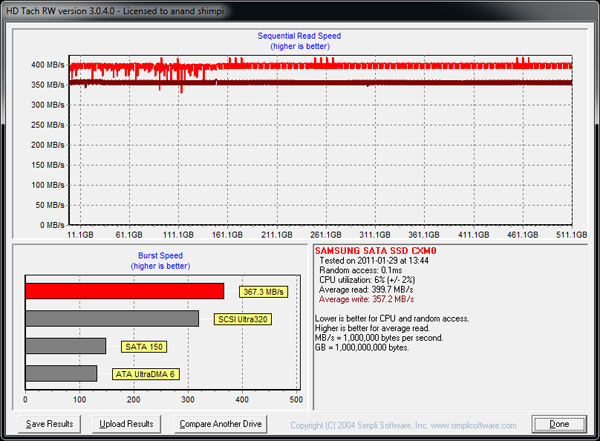The Samsung SSD 830 Review
by Anand Lal Shimpi on September 24, 2011 1:02 AM EST- Posted in
- SSDs
- Storage
- Samsung
- pm830
- Samsung SSD 830
Performance Over Time & TRIM
My biggest issue with Samsung SSDs in the past has been their extremely poor performance over time. Samsung doesn't do a lot of active garbage collection while writing in order to maintain ultra high write speeds, instead it prefers to clean up the drive during periods of little to no IO activity. Unfortunately this approach can result in pretty poor performance over time. In the old days the Samsung controllers would hit single digit write speeds, often slowing down to sub-HDD speeds. These days things are a lot better but it's still a concern. To quantify the behavior I filled all user addressible LBAs on the SSD 830, then proceeded to run our random write torture test on the now-dirty drive. After 20 minutes of torture I ran a single sequential read/write pass to measure how much of a hit the drive took.
Sequential read/write performance should be around 400/330 according to Iometer. Here's what the drive looks like after our torture test:
There's a significant drop in performance but the drive is still able to deliver ~100MB/s speeds. This graph is a bit deceptive however. After 20 minutes of 4KB random writes the SSD 830 will only write at a rate of around 20MB/s. By not doing much realtime garbage collection the random write speed can drop significantly over time, but at a lower write speed the 830 isn't penalized as much as other drives. To help deal with this issue I extended the length of our torture test to 60 minutes and re-ran:
Ah that's a lot more like it. Performance drops significantly, down to as low as 50MB/s for the earliest LBAs. Given enough idle time the 830 should correct much of this and obviously TRIMing those LBAs will restore full performance (as you'll see below) but the point is that by delaying the bulk of garbage collection the Samsung SSD 830 is able to drop in performance by a degree that I'm not super comfortable with. This phenomenon isn't exclusive to Samsung, you'll remember that we've complained about it with Crucial drives as well. Other than SandForce and Intel most controller manufacturers tend to follow a similar clean up the mess later approach to firmware design. In my opinion I'd much rather see lower peak performance and get higher worst case scenario performance as it tends to impact the user experience less.
If you are running under a TRIM enabled OS performance does restore to peak quite nicely after a TRIM pass:













99 Comments
View All Comments
spudit88 - Saturday, September 24, 2011 - link
Great review- I've installed several of the 470 Series and they have been very reliable. I don't believe we have had issues with any of them. These are mostly going into corporate laptops, so the fastest SSD's are not always the best option. I've stuck mainly with Samsung or Intel for reliability reasons. We are just now starting to deploy more laptops with 6Gb/s interfaces, it's good to know there are more choices out there....particularly with a larger drive option of 512GB.know of fence - Saturday, September 24, 2011 - link
The Sizes of these drives are multiples of 2, (64,128), does this imply that GB means the same as GB inside Windows, Gibibyte a.k.a 2^30 Byte or 1.073*10^9 Byte. Same as with RAM.Or does "GB" refering to SSD Sizes actually mean something completely different than MB (per second) in Speed Benchmarks.
know of fence - Saturday, September 24, 2011 - link
Sorry, It's all explained. Still a bummer, though.buzznut - Saturday, September 24, 2011 - link
Two years ago, Samsung seemed convinced the way of the future was hybrid drives that combined the best of both worlds-the capacity of a mechanical with the performance of an SSD. They had a lot of reliability problems with these drives, I expect that's why there aren't more of these drives on the market.What I am wondering is has Samsung completely abandoned this idea? What about other manufacturers? Do you think that the cost of producing such drives makes it impractical?
Some of the average performing SSDs have come down to the $1/GB price point, which is seemingly the magic number for those folks still hanging on desperately to their mechanical drives. Now I hear these same folks complaining about reliability being the main issue keeping them from adopting new technology, and they aren't wrong.
I haven't had any issues with my SSDs, I find them to be extremely reliable and now I don't think I could go back for a system drive. Initially I had an X25 40GB, now a 128GB Vertex III. So the reliability of the Samsung drives is refreshing news and I sincerely hope the drives will be priced competitively because I'd really like to see them succeed with this.
I still think, if implemented properly, that there is a market for hybrid drives. Don't know that anyone is willing to risk that though.
Evonick - Saturday, September 24, 2011 - link
I'm curious if anyone knows the actual time involved for idle time garbage collection, and whether that process is equivalent to TRIM? Anand mentions "overnight" in the review, but does itgc really take 8 hours? And when does it start? After 3 minutes of idle or 3 hours? And when the itgc is completed, how does the drive perform compared to a TRIMmed drive?FunBunny2 - Saturday, September 24, 2011 - link
-- I've been working on an enterprise workload suite to figure that out...In order for this to be "real", encrypted data input is required. The reason is that relational databases in Enterprise are increasingly configured with encryption.
tpi2007 - Saturday, September 24, 2011 - link
I Anand, congratulations for the review and the video review, both of which I enjoyed very much.I was looking at the power consumption figures and was wondering if Samsung's higher numbers could have to do with their use of DDR2 for cache ? And by that I mean two things:
1. The fact that it's much bigger than Intel's for example should add to the power consumption, adding to the fact that they store user data, which probably means more data being written and read from all the time, increasing power consumption;
2. The fact that it's DDR2. Is it low power DDR2 or just normal 1.8v DDR2 ? That could explain the higher power consumption to a certain extent too. What if Samsung were to use low power 1.35 or even better, 1.25v DDR3L ?
Best regards,
tpi2007
FunBunny2 - Saturday, September 24, 2011 - link
Along similar lines: why is there not a power loss test in the suite? There appears to be no superCap on the board, yet the part uses "massive" amounts of DRAM with user data. This looks like a bleeding Achille's heel.enigma80 - Saturday, September 24, 2011 - link
This worried me too. 256MB of user data in a limbo?It would be importante to test a power loss amid writing to the drive and check the data on the drive.
Obsoleet - Thursday, January 19, 2012 - link
Excellent points. I'd like to hear an answer to this.The more I read, the more I feel Intel is the way to go.. even vs this Samsung and M4s.